Holiday Titles Round-Up, Part Five:
Quite Possibly, the Finale
 December 17th, 2007 by jules
December 17th, 2007 by jules
So, here’s another round-up in my Holiday Book Challenge 2008, quite possibly my last round-up, since a). I’m getting busy myself with holiday preparations right now; b). so is everyone else, and I’ll be surprised if anyone even reads this at all; and c). if anyone is actually paying attention and taking notes and procuring titles, then I better get this done now, almost one week before Christmas, and not post any reviews any later. Some of these aren’t specifically “holiday” titles — just rather snowy. Enjoy.
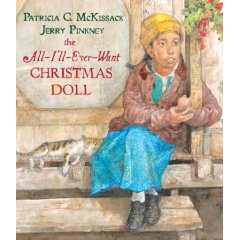
by Patricia C. McKissack
Illustrated by Jerry Pinkney
Schwartz & Wade Books
September 2007
(review copy)
This Christmas title opens with an author’s note about how McKissack was inspired to write this story while researching the forthcoming Stitchin’ and Pullin’: A Gee’s Bend Quilt, illustrated by Cozbi Cabrera (and which several places online said was published this year by Random House, though I haven’t seen it. One blogger who seems to be in the know says it’ll appear in ’08). McKissack visited a Mrs. Mary Lee Bendolph in Boykin, Alabama, and was entertained by stories of her childhood during the Great Depression in an all-black town identified as the “poorest place in America.” In McKissack’s story, it’s Christmas during the Depression, and three young African-American sisters are wondering if Santy Claus, who only shows up “once in a while,” will be visiting this year. Nella, the middle child, from whose perspective the story is told, longs for a Baby Betty doll and is delighted to find one on Christmas morning — along with some English walnuts, peppermint candy sticks, oranges, and raisins. When the three girls fight over the doll and their father shames them for fighting over a gift and orders them to “{w}ork this out and no more squabbling,” Nella reminds her sisters that she hoped and asked for the doll, even though they told her she wasn’t likely to receive one. As she tries to play with the doll (“I wish you would do something more than sit around like a spot on a toad”) while hearing her sisters pal it up outside, she finally decides to join them, handing the baby over to her sisters. They all have a tea party with the doll on the book’s final spread. Both author and illustrator have captured well a specific moment in time in the poor, rural South of the Great Depression — McKissack with her vivid characterization, traced with light moments of humor, and her detailed text and Pinkney with his luminescent pencil and watercolor illustrations of a poor family with very little possessions but lots of warmth and joy in the home. Best of all, it sings with a universal truth: Who wants that long-coveted, fancy-pants gift when there’s no one to share it with?
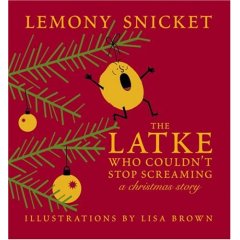
by Lemony Snicket
McSweeney’s
October 2007
(library copy)
The story begins in a “tiny village more or less covered in snow.” The children of this village have their faces pressed to the window, looking for the man they suspect will bring them gifts; instead, they hear an awful noise, coming from one of the cottages (“This cottage was already regarded with some suspicion, as it was the only place not decorated with flashing colored lights at this time of year”). It was a family baking a latke, and the latke — not unlike the Gingerbread Boy — began to scream, once he was put into a pan full of very hot olive oil. There he is on the next spread, leaping above a skillet, yelling “AAAHHHHHHHH!!!” And then again, the exact same illustration by Lisa Brown and his yell, on the next spread. His journey takes him past some colored Christmas lights, a candy cane, and a Christmas tree. None of them understand him or the Hanukah tradition of which he is a part (“So you’re basically hash browns,” the lights tell him, and “{s}omeone should write a Christmas carol about you,” says the candy cane), which results in two more spreads of him running and yellling. As the pine tree is about to tell him a story about pagan rituals, a family shows up in the forest, happy to find just the latke they’ve been looking for (“What was I thinking, bringing this axe?” the father asks himself). And this is the tragic, dramatic Lemony Snicket we’re talking ’bout here, so the latke gets consumed in the end (still yelling, as he’s popped into someone’s mouth) . . . Snicket succeeds in three ways with this book: He actually teaches you about some of the differences between Hanukah and Christmas (yes, in this short book, you learn about the defeat of Antiochus at the hands of the Maccabees and what it has to do with olive oil, the importance of lighting the menorah for eight consecutive nights, and a few more tidbits of information). And it’s also funny. Of course, what one person thinks is funny will baffle the next person, but I’m sorry, the “AAAHHHHHHHH!!!”s had me laughing out loud, despite (or maybe because of) their repetition (and then when the author adds “{t}his may seem like unusual behavior for a potato pancake, but this is a Christmas story, in which things tend to happen that would never occur in real life” — all this on a generous amount of white space but with a squirrel in a Santa hat popping out from the side, waving). Finally, it also serves as reminder that Hanukah is not the Jewish Christmas (do people still actually think that?) and is not all about presents. It is about hope and “the miracle of victory even when you are thoroughly outnumbered.” But it’s not too sentimental. This is Snicket, so it’s laced with dry, wry humor. See also Kelly Fineman’s review.
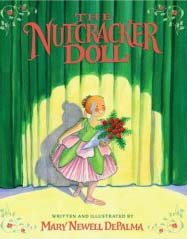
by Mary Newell DePalma
Arthur A. Levine Books
October 2007
(library copy)
by Susan Jeffers
HarperCollins
September 2007
(library copy)
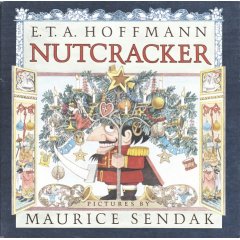 So, if you want some Nutcracker goodness this year, you have two choices: Mary Newell DePalma and Susan Jeffers. If you’re a purist and want E.T.A. Hoffman’s Nutcracker and Mouse King, which inspired Tchaikovsky’s ballet in the late 1800s, then by all means, turn to the Sendak-illustrated version of the tale, translated by Ralph Manheim. These two new picture book titles are for your wee’er ones, though — one focusing on a ballet performance, those things having become an annual tradition in many cities at Christmas, of course, and the other offering up the story in its simplest form for the “picture-book-age child” . . . In DePalma’s tale, we meet Kepley, a young girl taking ballet who sees her first performance of The Nutcracker and is instantly hooked. After auditioning, she gets the part of a doll in the production and is “carried offstage by a man prenting to be a giant mouse!” (which makes her giggle every time). One day, she hopes, she can dance the Waltz of the Flowers, “but for now, being a doll was a dream come true.” That doesn’t sound like much, but what DePalma does well is capture the backstage giddiness of being in a show and the awe of being in your first production, standing in the bright lights and performing for a large crowd. It’s a gently-paced, sweet story of what being stagestruck feels like. Publishers Weekly wrote: “DePalma’s straightforward text and streamlined, representational watercolor illustrations look simple, but they incorporate the details that authenticate the story and make readers feel like insiders: the girls giggling at rehearsal, dancers in costume taking pictures of each other, the signs in the costume room.” It really does work, and it’s the perfect title for the ballet-crazed child in your life . . . Jeffers offers up a simple re-telling of the Nutcracker tale for the youngest child, explaining in an Author’s Note that all the Nutcrackers available “seemed to have intricate and lengthy texts” as well as an absence of the ballet. “My affection for The Nutcracker fairy tale is rooted in the ballet,” she tells us. What we have here, then, is a picture book that follows the ballet and not so much the complicated Hoffman fairy tale, making this yet another title for the ballet-lovin’ children you know. It does the job of introducing the skeleton of the story to the youngest of readers, and Jeffers illustrations are lush, precise, exuberant. Recommended for adding to your holiday pile.
So, if you want some Nutcracker goodness this year, you have two choices: Mary Newell DePalma and Susan Jeffers. If you’re a purist and want E.T.A. Hoffman’s Nutcracker and Mouse King, which inspired Tchaikovsky’s ballet in the late 1800s, then by all means, turn to the Sendak-illustrated version of the tale, translated by Ralph Manheim. These two new picture book titles are for your wee’er ones, though — one focusing on a ballet performance, those things having become an annual tradition in many cities at Christmas, of course, and the other offering up the story in its simplest form for the “picture-book-age child” . . . In DePalma’s tale, we meet Kepley, a young girl taking ballet who sees her first performance of The Nutcracker and is instantly hooked. After auditioning, she gets the part of a doll in the production and is “carried offstage by a man prenting to be a giant mouse!” (which makes her giggle every time). One day, she hopes, she can dance the Waltz of the Flowers, “but for now, being a doll was a dream come true.” That doesn’t sound like much, but what DePalma does well is capture the backstage giddiness of being in a show and the awe of being in your first production, standing in the bright lights and performing for a large crowd. It’s a gently-paced, sweet story of what being stagestruck feels like. Publishers Weekly wrote: “DePalma’s straightforward text and streamlined, representational watercolor illustrations look simple, but they incorporate the details that authenticate the story and make readers feel like insiders: the girls giggling at rehearsal, dancers in costume taking pictures of each other, the signs in the costume room.” It really does work, and it’s the perfect title for the ballet-crazed child in your life . . . Jeffers offers up a simple re-telling of the Nutcracker tale for the youngest child, explaining in an Author’s Note that all the Nutcrackers available “seemed to have intricate and lengthy texts” as well as an absence of the ballet. “My affection for The Nutcracker fairy tale is rooted in the ballet,” she tells us. What we have here, then, is a picture book that follows the ballet and not so much the complicated Hoffman fairy tale, making this yet another title for the ballet-lovin’ children you know. It does the job of introducing the skeleton of the story to the youngest of readers, and Jeffers illustrations are lush, precise, exuberant. Recommended for adding to your holiday pile.

by Anne Bowen
Illustrated by Tomek Bogacki
Carolrhoda Books, Inc.
October 2007
(library copy)
In this highly festive title, a young girl tries to explain to her new baby brother all the traditions of Christmas that her family celebrates and all of the hallmarks of the season: snow and frost on the window; lights “like ribbons of stars shining in the dark”; “{w}hen Mama brings out the red berry wreath and Daddy brings down the boxes from the closet . . .”; writing letters to Santa; making cookies to share with the neighbors; and more. But the entire book is really an homage to the almost torturous anticipation of Christmas that some (but certainly not all) children experience: “Waiting for Christmas can be harder than waiting for your birthday or waiting for summer or waiting for a visit from Grandma and Grandpa. But there are things you can do to help the waiting.” And our young protagonist then spells out those ways. But, though she talks about presents, racing downstairs on Christmas morning to count them, and the other more tangible joys of the season, it all comes back to being with her family around the Christmas tree and the one special thing they all have this Christmas: “YOU,” she tells her baby brother. “And that is the best present of all!” Bogacki as illustrator for this title was a good choice; his paintings of familial contentment (such as, in the award-winning Five Creatures) radiate warmth. A good choice for those families who celebrate Christmas in the traditional ways, whether secularly (there is no mention of the birth of Christ — or anything else religious, for that matter — in this one) or not.

by Lynn Plourde
Illustrated by Mitch Vane
Charlesbridge
June 2007
(review copy)
Let’s take a break from the holidays for a few snowy titles. Here we have Lynn Plourde’s and Mitch Vane’s tale of some rather forgetful elementary students. “It was that time of year again” (make that Winter), and — though her parents remind her not to — Molly leaves her mittens at school. Really, she just felt some pity for the poor classroom turtle who was sneezing and figured cuddling in her mittens would make him feel cozy. Her teacher, Mr. Jolly, adds them to the ever-growing lost-and-found pile, followed by the book’s repeated refrain: “Mittens, Mittens. My, oh, My! A Mountain of Mittens, Piled up high.” After promising her parents she won’t lose them again (and after her parents Velcro them to her coat), sure enough she loses them in music class along with some of her classmates. Miss Holly finds them and adds them to the pile. Throw in some duct tape, and you get the picture. An emergency assembly is eventually called by Mrs. Folly, the prinicipal, who declares that no one will be leaving school that day ’til all the mittens are reclaimed. But all that Velcro and tape and yarn has the opposite effect — the students get stuck to and stuck in the massive pile: “Molly, Mr. Jolly, Miss Holly, Mr. Golly, Mrs. Folly, and more. My, oh, My! A Mountain of people, Piled up High.” It’s pure winter-time silliness (though, as you can note above, it was published back in the summer), and Vane’s loose, relaxed watercolor illustrations complement well the carefree tone of the story.
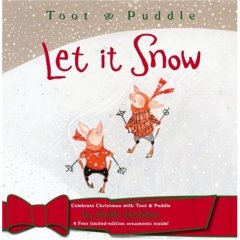
by Holly Hobbie
Little, Brown and Company
October 2007
(library copy)
I admit that I’m not terribly up on my Toot & Puddle books. ‘Tis a shame, I know, seeing as how they are two characters in the Frog-and-Toad-esque and George-and-Martha-esque tradition of great friendship. This new holiday title celebrates that friendship in a rousing and poignant way: As the two try to find just the right gifts for one another (Toot knowing that “the best present was usually something you made yourself, a one-of-a-kind thingamajig, not just a whatsit anyone could buy in store”), they take a break to play in the newly-fallen blanket of snow outside. After “the glorious snow” is gone, which really bums Puddle out, Toot makes him a sled that works in snow or no-snow, and Puddle gives Toot a painting to capture for all enternity their special, snowy day in the woods. Puddle’s cousin, Opal, makes an appearance, but at the heart of it all is the singular Toot and the singular Puddle (“they’re best friends, but one is one way and one is the other,” says Opal) and their friendship. What I love, in particular, are Hobbie’s word choices and sentence constructions: “His spirits had momentarily been dampened”; “the two friends plunged into a state of busy excitment”; “Toot tried to remain calm, but couldn’t quite suppress his eagerness.” Hobbie, in the tradition of Beatrix Potter, knows that children dig those big, fancy words and are always in tune to adults and the way in which they use more complicated words to express precise feelings and actions. Hobbie’s watercolor illustrations are endearing without being cloying, and I love how she makes the final spread, Puddle’s painting for Toot, simple and primitive — yet it doesn’t look like an illustrator trying too hard to make a child’s drawing. A highly recommended and warm snow-time read.

by Jan Brett
Putnam Juvenile
September 2007
(library copy)
This is a rather unusual re-telling of Goldilocks and the Three Bears, this one set in the Arctic landscape and featuring a young girl named Aloo-ki and her sled dogs. Beginning the action on the title page, Brett introduces us to Aloo-ki, who has lost her huskies on an ice floe. While searching for them, she lets her curiosity get the best of her, wandering into an igloo not her own. It belongs to three polar bears — Papa, Mama, and Baby Bear — who set out on a walk in the wintery weather to let their soup cool. Aloo-ki taste-tests all the soups, eventually devouring Baby Bear’s, and . . . well, you know how the story goes, except in this one, Brett skips the rocking chair bit and heads straight for the bears’ warm, winter boots. Aloo-ki falls asleep in Baby Bear’s boots and in Baby Bear’s bed. All the while, the bears have spotted Aloo-ki’s huskies and dove into the water to push them back to land, right next to their igloo where Aloo-ki, unbeknownst to them, is sleeping. How do we know this while simultaneously taking in Aloo-ki’s adventures? Because Brett includes on each spread a left and right side panel of illustrations, which show us the bears’ attempt to save Aloo-ki’s dogs. The rest of Aloo-ki’s tale follows the traditional story, except that when the bears arrive home, she dives between Papa Bear’s huge legs, greets her huskies outside the bears’ door, and flies over the frozen ice, waving a thank-you. The bears wave some suddenly-exuberant farewells, though inside the igloo they were, quite frankly, pissed off and roaring rather loudly in indignation over their intruder. Brett traveled to Iqaluit, the capital of the Nunavut Territory in northern Canada, to research this title and meet the Inuit people. I’ve met teachers who would jump in front of a train for Jan Brett, big fans of her trademark style — those detailed illustrations and borders and panels. She delivers that here, as always, and her intricate, reverent illustrations reflect her travel and research, though the story falls a bit flat, especially with that somewhat inconsistent ending.
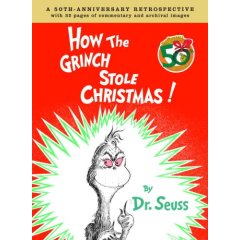
by Dr. Seuss
Commentary and archival images provided by Charles D. Cohen
Random House
September 2007
(review copy)
Here’s the 50th anniversary edition of How the Grinch Stole Christmas!, including the complete original text and illustrations and thirty-two pages of commentary from Charles D. Cohen, who is, of all the things, a dentist who adores Seuss, has since he was a child, and collects “Seuss esoterica
. . . Today, Dr. Cohen’s trove of Seussiana is likely the most comprehensive private collection in the world.” He hopes to found a museum for it all one day. Anywho (get it?), his commentary on this famous Christmas book is reverent, if not slightly giddy (he likes to use exclamation marks!!), and the man knows his Seuss. He touches on how the Grinch was, in part, based on Geisel himself; the origins of the story; and the many changes the title character, Max, and the Whos have undergone over the years in various and sundry television adaptations. Cohen stresses Geisel’s desire to write a tale about “the true spirit of friendship and community,” noting that his tale doesn’t end with a promise of presents to come every year. Instead, it ends with a dinner of fellowship between the Grinch and the Whos:
Dr. Seuss wanted to teach children that even though people may look different or come from different places, they can come together as friends. And even though this is a Christmas tale, Dr. Seuss never mentions religion in the story. In fact, he claimed, “I spent three months on the last page of ‘The Grinch.’ It kept turning into a religious tract.”
Interesting stuff. And those of you who enjoy reading about the history of children’s publishing and Ursula Nordstrom-type anecdotes on the world of publishing will enjoy the insights, my favorite being:
When asked what he thought about PhD theses based on his work, Ted replied, “I think they’re a ridiculous waste of time. . . . People who are working for their doctorates . . . [will] take a book of mine that has one color in it and talk about my great sensitivity in handling that color, and why I chose that color, when the fact is that Bennett Cerf {Ted’s publisher at Random House} called me up one morning and said, ‘We’re having a bit of a financial problem, so cut down your colors.'”
There are all kinds of rarely-seen Seuss images, including “Perfect Present,” Seuss’ poem about the ideal gift; “The Hoobub and the Grinch,” a story in verse about a con artist; and the poem-painting, “A Prayer for a Child.” All in all, it’s a fascinating, deferential look at a story that has captured so many people’s interest over these fifty years, even those who say humbug to the holidays, as they can relate themselves to the Grinchy, cranky aspect of the tale. An inviting look at what is considered a children’s classic.

by Kate DiCamillo
Illustrated by Bagram Ibatoulline
Candlewick
October 2007
(review copy)
You know what I want to do for this title? I simply want to send you to this link (you must register to read it, but it’s free) at the New York Times. It also includes a review of the children’s edition of Angela and the Baby Jesus by Frank McCourt and illustrated by Raúl Colón, which looks really interesting and I’ve got on hold at my local library. Raúl Colón’s art work: Ooh la la. Anyway, so I stumbled upon these reviews before sitting down to compose my own thoughts about Great Joy, and I agreed with this reviewer, Sarah Ellis, so much that her words won’t leave my head (thanks to Susan at Chicken Spaghetti for the link). Before I give you an excerpt of Ellis’ review, here’s a brief run-down of the book’s plot: It’s America, circa 1940s. A young girl, who is getting ready for her church’s Christmas pageant, sees a homeless man, an organ grinder, on the street with a monkey on his shoulder. She’s very concerned about him, but her rather harried, hard-hearted mother keeps changing the subject when the girl suggests things like inviting him to dinner. Finally, she has a brief opportunity to tell this homeless man about the play at the church, and he appears as she’s delivering her line on stage, all dressed up as an angel, about bringing tidings of great joy. “And because the words felt so right, Frances said them again: ‘Great Joy.'”
Here’s an excerpt from Ellis’ review:
Memorable picture-book texts often emerge when two stories entwine. In “Angela” the story of Pat winds around the story of the liberation of the baby Jesus, giving it strength and universality. It is Ireland in the 1910s, and it is all other times as well. In “Great Joy” the two strands of the plot — pageant and organ grinder — don’t convincingly mesh, and neither has enough substance or originality on its own. To invite a homeless person to come in from the cold for a couple of hours is not a sturdy enough premise to justify the emotion the narrative seems to be asking of us.
Word. She goes on to say that we allow holiday titles an “extra measure of sweetness,” since they wear their messages on their sleeves — but that we should still demand good storytelling from them. “Fully realized characters, nongeneric places and voices, an acknowledgment that virtue is complicated — these are what make the message palatable and create a space for yet one more Christmas tale.” The book has also been criticized for its heavy dose of sentimentality. I dunno, I think it almost works here, but I’m having trouble removing myself from the fact that, as a child myself, I’d be devastated for days when I saw a homeless person or, say, a homeless dog or some such thing (didn’t we all?). But I do concur that the story is not sturdy, as Ellis puts it, and rather bland, and what saves it at all is Ibatoulline’s very detailed, exact, and evocative acrylic gouache illustrations. To me, this is very much like Edward Tulane in that it seems to be marketed squarely at nostalgic adults. But, really, I invite comments, as always: Other thoughts? Anyone else (who might still be with me here)?

by Rob Scotton
HarperCollins
October 2007
(library copy)
Fans of Russell the Sheep may be happy to know he has a new holiday story out. It’s Christmas in Frogsbottom Field, and Russell’s attention is snagged by what he thinks is a shooting star. It snuffs out all the lanterns in Firefly Wood, which ruffles Russell’s feathers a bit (say that three times fast), so to speak, and “he trudged off to investigate.” Well, Santa’s crashed and is distraught that Russell can even see him, since that means the Christmas spell is broken. Santa’s all eager to cancel Christmas when Russell finds a rusty old car and hammers and saws ’til he has created “a thing of beauty, a work of genius!” (says Santa) — a slammin’ red sleigh car, of sorts. Suddenly, Santa and his reindeer start to disappear. This is a good thing, if not slightly bizarre to young children; it means Russell set that Christmas spell back into motion. Still, off they zoom through the sky, Russell even joining Santa on his journey that night. Publishers Weekly wrote, “Russell’s latest lacks the spark of droll humor that fueled its predecessors; the quirkily introspective sheep’s exploits lose something when Santa shares the spotlight.” I can see what they mean, though diehard Russell fans may not be disappointed and it has its moments of joy, particularly that choice red sleigh/car contraption and the wonder in Russell’s eyes as he sees Santa on his way.
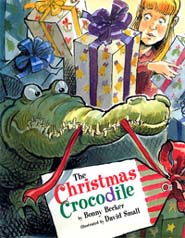
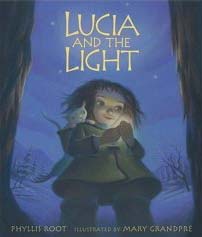 Three quick notes: I finally read Bonny Becker’s and David Small’s The Christmas Crocodile (Aladdin; 1998). So funny. Where has this book been for me all these years? Also, don’t forget the beautiful and lovely-in-every-way Lucia and the Light (Candlewick; 2006) by Phyllis Root and illustrated by Mary GrandPre. Finally, I haven’t seen it myself yet, but apparently Ellsworth has conducted a holiday play, “Winchester’s Christmas Carol,” just for children at Ellsworth’s Journal.
Three quick notes: I finally read Bonny Becker’s and David Small’s The Christmas Crocodile (Aladdin; 1998). So funny. Where has this book been for me all these years? Also, don’t forget the beautiful and lovely-in-every-way Lucia and the Light (Candlewick; 2006) by Phyllis Root and illustrated by Mary GrandPre. Finally, I haven’t seen it myself yet, but apparently Ellsworth has conducted a holiday play, “Winchester’s Christmas Carol,” just for children at Ellsworth’s Journal.
Happy holidays to all . . .

I have been searching and searching all this season for the name of “that christmas book about a crocodile or alligator” I searched all kinds of databases. Why didn’t they return “A Christmas Crocodile?” Too obvious I guess. Thank-you
Glad to see you recommend the Snicket book (one I suggested in response to your earlier request for holiday books). If you or anyone is interested I have a post about reading it aloud to my class here:
http://medinger.wordpress.com/2007/12/04
Whew! This round-up feels like a breakneck gallop through the Twelve Days of Christmas! I totally forgot about the 50th Anniversary of Grinch. Thanks for reminding me of this book and alerting me to other new ones.
Oh thanks, Monica! Looking forward to reading that. I totally meant to do a search for other posts about it.
OK, I’ve loved these lists. And I love me some Toot and Puddle so that’s a must. We always pack up our holiday books with our stockings and ornaments every year — so they’re a thrill when we unpack. I think I might have to add to the box again…
Thanks…
Wow, lots of goodies! I’m really trying to read and catch up. By the way, a Nutcracker book I’d recommend in addition to the ones listed is the photographic one put out by the Pacific Northwest Ballet: http://www.amazon.com/Pacific-Northwest-Ballet-Presents-Nutcracker/dp/1570614695/ref=pd_bbs_sr_1?ie=UTF8&s=books&qid=1197913129&sr=8-1
It’s the one that’s most accessible for my four year old (who’s attending that ballet for the 2nd time this Saturday).
Of all the titles listed, I’m most interested in the All-I’ll-Ever-Want Christmas Doll. Reading the description reminds me of that time when Ma Ingalls made Laura give her beloved doll Charlotte to some brat who clamored for it. Do you remember that? And then Laura found Charlotte in the rain and mud somewhere, and went home to tell her Ma that she “stole” Charlotte. I can’t remember if Ma was penitent or not, but it only strengthened my case against Ma.
Boy, I’m a Ms. Grouchy-Boots.
Alkelda (I mean Al), do you remember the “Ma cooks. Ma sews. We love her” episode (from TV — I have no idea if it’s in any of the books)? Heh. I swear, if I catch reruns of that show, I am immediately transported back to my childhood.
Thanks for the feedback, Liz, and everyone else!
Thought I’d include an image of the cover of Frank McCourt’s Angela and the Baby Jesus, mentioned in this post and which I picked up today from the library and enjoyed. It’s his tale of something that happened to his mother when she was six-years-old. If you’re a fan of Angela’s Ashes, you might enjoy it. And Raúl Colón’s illustrations are lovely.
There’s also Mike Reiss’ new Christmas title, Santa’s Eleven Months Off, which we also got today and whose illustrations by Michael C. Montgomery are a hoot-and-a-half. (Reiss did last year’s Merry Un-Christmas with illustrations by David Catrow, which I reviewed here last year).
Jules– Amazingly enough, I never watched LHOTP on a regular basis (no tv in our house for many years), but that episode I remember. I got to watch at least 1/2 of that episode. If I remember correctly, tv Ma was a more sympathique character than book Ma.
You know I’m with you for Snicket. I also loved Toot & Puddle (and bought it for M for her 13th birthday, at her request, for old time’s sake, because we loved the early pbs together).
And I thought Great Joy didn’t totally live up to its promise/hype, but I was enraged that there were no minorities in any of the illustrations even more than I was upset about the text itself, which I agree is marketed to grandparents, even, not parents.
Yeah, Kelly, I read your review of it. I should have linked to it. And, yes, the latke book is all Snicket. Very funny. And a hit with Monica’s students.
Jules, Thanks for doing all my Christmas collection development work for me. 🙂 This series ROCKED.
I am dying to read the Snicket, but everyone in my system who owns it won’t loan it to other libraries through our holds system. Somehow I haven’t run into it in a bookstore. I must make a particular point of looking for it.